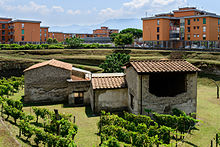 Villa Regina, view from above | |
| Location | Boscoreale, Province of Naples, Campania, Italy |
|---|---|
| Region | Magna Graecia |
| Coordinates | 40°45′41″N 14°28′17″E / 40.761389°N 14.471389°E |
| Type | Dwelling |
| Site notes | |
| Management | Soprintendenza Speciale per i Beni Archeologici di Pompei, Ercolano e Stabia |
| Website | Sito Archeologico di Boscoreale (in Italian) |
Villa Boscoreale is a name given to any of several Roman villas discovered in the district of Boscoreale,[1] Italy. They were all buried and preserved by the eruption of Mount Vesuvius in 79 AD, along with Pompeii and Herculaneum.[2] The only one visible in situ today is the Villa Regina, the others being reburied soon after their discovery. Although these villas can be classified as "rustic" (villae rusticae) rather than of otium due to their agricultural sections and sometimes lack of the most luxurious amenities, they were often embellished with extremely luxurious decorations such as frescoes, testifying to the wealth of the owners. Among the most important finds are the exquisite frescoes from the Villa of Publius Fannius Synistor and the sumptuous Boscoreale Treasure of the Villa della Pisanella, which is now displayed in several major museums.
In Roman times this area, like the whole of Campania, was agricultural despite its proximity to cities including Pompeii, and specialised in wine and olive oil.[3]
Information on, and objects from, the villas can also be seen in the nearby Antiquarium di Boscoreale.
- ^ "Villas in Pompeii and in the area between Vesuvius and Stabia". Pompeiiinpictures.com. 24 October 2021. Retrieved 14 May 2022.
- ^ "Boscoreale - AD79eruption". sites.google.com.
- ^ Hornblower, Simon and Antony Spawforth. Oxford Classical Dictionary. London: Oxford University Press, 1996. 254.